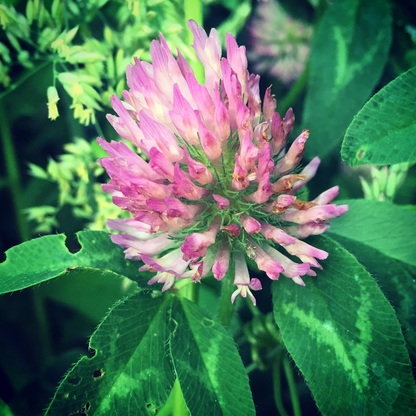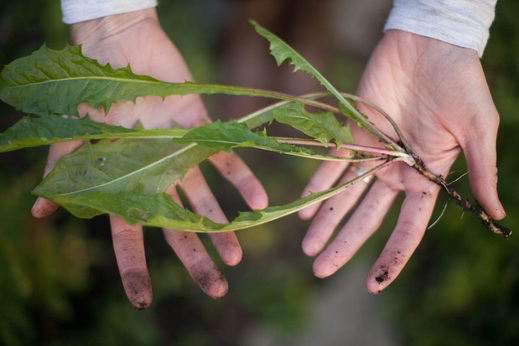 Summer is a busy and a beloved time for any herbalist - the plants are out in full force and it is time to garden, grow, harvest, process and preserve the abundance of fresh herbs for use throughout the rest of the year. It is a time that I always eagerly await, but it is also a season that passes very quickly. Many plants have a short window of time that is optimal for harvesting, and even if I plan on collecting certain herbs, sometimes I don’t get to everything on my list. The rhythm of the seasons is an important teacher, and I always keep in mind the line of poetry, “Gather ye rosebuds while ye may, Old Time is still a-flying….” To help you gather your rosebuds and other delightful plants while they are still in their prime, here is a quick list of five of my favorite herbs to collect and use at this time of year. Take a look around your neighborhood and see if you can spot any of these wild or cultivated beauties: Red Clover blooms abundantly throughout the summertime. Look for flowers that are vibrantly colored, and skip those that look wilted or tired. To dry, place the blossoms on a window screen so that airflow can reach all sides of the flower; also make sure the flowers do not touch one another. Use dried red clover blossoms in nourishing tea blends; it mixes well with other herbs like nettles, burdock or dandelion. Calendula is a prolific garden bloomer throughout the whole growing season, hence it’s name, which relates to its ability to flower in every calendar year (if grown in a warm environment). Collect the flower tops when they are freshly opened, and be sure to keep the resin-filled green sepals which surround the petals. Save dried calendula flowers to throw into your fall and winter soups for an immune-supportive addition. Mugwort can be found growing in disturbed areas and along roadsides (but be sure to avoid collecting near traffic-laden roads.) Clip the tall stalks so that you are harvesting the upper third of the plant. The best time to collect mugwort is right before its very tiny flower buds open. Hang a bundle of the stalks upside down to dry. Use mugwort leaves in bedtime teas to stimulate vivid dreams (really!), or blend with herbs like mint, sage and fennel for a nice digestive tea. Mullein is another wild-growing plant, and one of my favorites. I love spotting its fuzzy leaves and tall, majestic stalks throughout the cityscape. Collect the basal leaves from first or second year plants (mullein is a biennial), or patiently collect the lovely yellow flowers as they emerge. The leaves can be dried on a screen or on brown paper bags and used in an old-fashioned steam to support respiratory health. The flowers are traditionally infused in oil to alleviate ear aches. Dandelion leaves can be collected throughout the growing season. As the summer wears on, the leaves will become more and more bitter, but I find them delicious at any time of year. You can either harvest fresh dandelion leaves to dry and use for tea or you can incorporate them into your food. I love to sautee fresh dandy leaves with some onion as a lovely and nutritious side dish. If you are new to harvesting herbs here are a few tips to get you started:
I hope these tips inspire you to do some of your own herb harvesting this season. I’d love to hear what you are collecting - please be in touch! To learn more, consider joining me in one of my upcoming herbal classes. Happy harvesting! Resources: Medicinal Plants and Herbs (Peterson Field Guides) by S. Foster & James A. Duke Edible Wild Plants (Peterson Field Guides) by Lee Allen Peterson A City Herbal by Maida Silverman Edible and Medicinal Plants by Steve Brill Wild Urban Plants of the Northeast by Peter del Tredici  There are so many amazing – and usually overlooked -- plants that grow right at our doorsteps, in sidewalk cracks, and throughout abandoned city lots. Many of these plants, often condemned as “weeds”, are in fact wonderful examples of how plants can survive, and even thrive, in the harshest of growing conditions. Have you ever wondered how those tenacious dandelions manage to grow in sidewalks where soil and water are not easy to come by?.... Many of these so-called weeds are medicinal herbs that possess healing properties or are nutrient-rich wild foods. Humans have had a relationship with these plants for centuries, using them to stay healthy, strong and nourished. So here’s a brief run down of four of my favorite urban street plants and their medicinal and edible uses: Burdock Arctium lappa With broad, fanning leaves and a stalk of magenta thistle-like flowers, burdock is a noticeable plant in many corners of Somerville. The root is much esteemed as a food and can be harvested in early spring or late fall to eat sautéed or roasted, much like carrots. It has a sweet, meaty flavor that is very fortifying. Medicinally burdock is a plant that is incredibly nourishing for the body and gradually helps to re-build overall strength and vitality, especially in cases where someone is depleted and run down from stress. It is also great for skin issues such as itchy, rashy skin, eczema and acne. Burdock helps to clear out toxins from the system (which can manifest as skin problems), and supports liver function. This herb is best taken consistently over the span of many months for noticeable results, as it is slowly building and nourishing.  Dandelion Taraxacum officinale The ubiquitous dandelion is found all over town. This cheerful yellow flower, the bane of many gardeners, blooms from early spring throughout the growing season. It seems that the more you try to weed it out, the more it will grow back. Dandelion is a persistent and prolific plant, but fortunately so, for it is one of the single most beneficial herbs for humankind. Both the leaves and the roots are used medicinally to support liver health. It is also a prime herb for digestion – with its very bitter taste it stimulates our gastric juices, prepares our bodies to digest food, and helps with the assimilation of fats and nutrients. I find that drinking a tea of dandelion over several days helps me feel fresh, happy and invigorated, as if my liver were thanking me for treating it so kindly. Dandelion leaves and flowers can both be added fresh to salads, a beautiful way to use the abundance of this plant during the growing season.  Plantain Plantago spp. What an adaptable creature this humble weed is – you will see plantain growing in sidewalk cracks, waste lots, abandoned areas, places with poor soil, little soil, pollution, i.e. in places where most plants would not even think about growing. Fortunately for us this inconspicuous herb is a kind friend for humans, and many herbalists call it the Band-Aid plant or the First Aid plant. Indeed, plantain helps us with all sorts of minor issues and can be used topically as a poultice for wounds and scrapes, sunburn, itchy bug bites and even poison ivy. (It once helped me quite well with a bad case of poison ivy outbreak.) Next time you become mosquito food, try placing a crushed (or chewed up) plantain leaf on the area that has been bitten – see if you don’t notice that the itch and swelling is relieved almost immediately.  Mullein Verbascum thapsus Mullein is a plant that you will see growing throughout much of the US, and although it is not a native plant it has now become naturalized throughout much of the country. Another name for this useful plant is Lungwort, which gives a clue that it has traditionally been used for all diseases of the lungs and upper respiratory system. It has helped people with asthma, coughs and pneumonia, mostly by use of an old-fashioned steam bath. Furthermore, the beautiful yellow flowers that bloom on the mullein stalk are still used to this day to treat ear infections, especially in children. This is one of my favorite plants, and at this time of year you can see the two-year-old mulleins blooming along the highways and in forgotten area. When it comes to harvesting any plant material in the city, please do use your good judgement. Gather plants that you know are growing in clean areas, away from road traffic and pollution, and also consider the soil quality. As always, you want to be mindful of the health of the surrounding environment when you are collecting plants for edible or medicinal use. If you are unsure, do not collect. A win-win situation is to ask gardeners and farmers if you can come and collect their pesky (but useful) "weeds". Happy plant harvesting! This post was originally published on the Somerville Urban Ag blog |
Categories
All
Archives
January 2022
|




